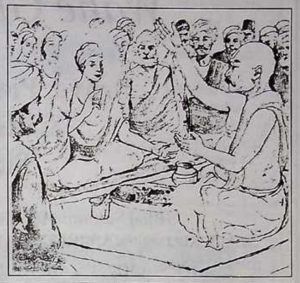
All Hindus belonging to the different classes undergo the threat wearing ceremony. In this ceremony, a child after eight years of age is domed with a cord’ slung Over the shoulder which hangs down to the waist, the thread Wearing is important for Hindus, because one who doesn’t have a thread is considered a Sudra or ‘belonging to a menial class even proclaimed untouchable. The thread is considered sacred.
The thread consists of a specified number of strands (threads or Strings) is made of a specified fabric and worn al a particular season of the year as governs the class of the wearer, A Brahman, the highest of Hindu classes wears a cord of five strings, it should be made of cot ton fabric and is domed during the Spring season, A Kshatriora per $n belonging to the warrior class, wears a thread of three strings, made of jute and first darned in the Summer session. The Vaisha or farmers or traders class people wear of thread of two strings, made of wool and its domed in the Autumn season. Once the thread has been domed, the Hindu has to wear it all the time all his life. The lowest people known as Sudras and women are not entitled to wear threads. Women, are thus grouped with the menial or untouchable class in Hindu society.
When Guru Nanak was about 10 years old, his father called the head priest, Mehta Kalu to perform the thread wearing ceremony of his son. He invited all his relatives and friends for the event as it was an important function and he made collaborate arrangements for his guests.
Pandit Hardyal started the ceremony by reading “Mantras” or hymns from the scriptures and when this was done he moved to put the thread around Guru Nanak. The child Nanak gently held back the hand of the Pandit and softly asked, “O! Pandit, of what use is this thread that you wish to place around my neck? It discriminates between men, gender, the number ‘of strings, the type of fabric and even the seasons of the year. Its perishes or breaks m course of time. When a man dies, it gets burnt with his body. Everyone is to God’s home thread Jess.” Pandit Hardyal asked Nanak, what type of a thread he wished to have. Guru Nanak replied that he would like to have a thread that did not get soiled nor get burnt, which satisfied the spirit within man. “If such a thread you have, gladly would I dorm it,” said Guru Nanak. There was furor in the assembly of people who had come to ‘witness the ceremony, they were amazed to hear the words of such a young child who questioned the purpose of an age old tradition. Some tried to persuade him to wear the thread offered by Hardyal Pandit and his father felt exasperated, But in spite of his tender age Guru Nanak did not relent and courageously resisted a ritual based on ignorance and which symbolized discrimination amongst men.
Definition of Guru Nanaks thread; When the people at the assembly asked Guru Nanak what type of thread he would like to wear he said, “Take the cotton of kindness and spin the thread of contentment, tie the knot of truth and virtue. I want to wear a sacred thread having these qualities. Everyone should wear such a thread.” Such a thread will never get soiled or break nor get lost. A man with such a thread is truly blessed. Such a thread cannot be had from a market place.
Pancht Hardyal was dumb struck but he did not want to accept that he a Brahmin had been humbled by a young child, so he persisted. Addressing Nanak he said, ‘Dear child, you must respect the custom Started by the great sages and saints of our religion, A Hindu without a thread is a man without religion, You are surely a religious person, so you must Dom this thread.”
Guru Nanak asked, “What religion do you speak of O Pandit jee. I see men of authority com mitting foulest deeds, they rob and kill, tell lies and deceive, are lustful and greedy and commit a thousand sins and crimes against their fellow men. Their souls are polluted to the core. Is this the religion which your thread confers on them. I would have none of it.”
Pandit Hardyal thought he would pacify Nanak by promises so he said, “we will search for such a thread for the soul, but in the meanwhile you should wear the one I offer you for the body.”
Guru Nanak asked Hardyal Pandit, “Are you sure you can produce such a thread? | find none anywhere he can do so. There is no string to bind sexual desires, nor lust nor vices, there exists no string that restricts one’s hands and feet to keep them away from evil doings. There is no string for a tongue, nor eyes (0 keep them from sensual or sinful pleasures.
Hardyal was rendered speech less, the assembly was shaken, they all realized the truth of Guru Nanak’s divine words. Hardyal Pandit bowed before the Guru and others went away mused of the Godly words of Guru Nanak.
Rai Bular, the local ruler and a devotee of Guru Nanak who had been invited for the ceremony was thrilled and felt wonderfully happy to hear the sermon of Guru Nanak and congratulated Mehta Kalu for being blessed with a son like Nanak.
However Mehta Kalu still did not understand the behavior of his son Nanak and felt heartbroken at his not have worn the thread.
Tarlok Singh Sandhu Fremont, CA
Article extracted from this publication >> May 14, 1993